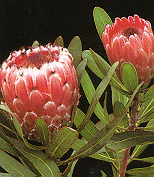
Hawaii Cooperative Extension Service
Horticulture Digest #102
RECENT PROGRESS IN DRACAENA DECLINE AND AGLAONEMA FOLIAR BLIGHT RESEARCH (1990-1991)
Editors Note: Summary of March 1992 presentation to growers in Hilo, Hawaii.
 Dracaena Decline
Dracaena Decline
 CAUSE:
CAUSE:
Research on Dracaena decline caused by Pythium graminicola was continued. A major effort to develop a selective medium to isolate P. graminocola is in progress. Pythium graminicola is a very aggressive pathogen, but grows poorl
y without the host. Although able to survive in soil as specialized spores with thickened walls, it competes poorly with other micro-organisms. Unless nutritional and other environmental factors strongly favor its growth, P. graminicola cannot be d
etected in soil.
Results.
Although some growth differences were observed, tests are continuing to improve selection of P. graminicola.
Experiment.
Using a basal medium (nitrogen and carbon sources, minerals, and vitamins) plus 10 other compounds (bacterial inhibitors, non-Pythium fungal inhibitors, and growth regulators), over 40 different agar combinations have been tested thus far. These te
sts employed 12 different fungal isolates, including isolates of P. graminicola, P. splendens, P. helicoides, P. aphanidermatum, and Phytophthora.
Results.
Fifteen isolates tested were strongly pathogenic to Dracaena; 2 were not. The non-pathogenic isolates were similar morphologically, but may belong to different species. Taxonomic studies are continuing. Increasing the number of P. graminicola isolates broadens the genetic base on which the biology of this species can be evaluated.
Other fungi collected from diseased Dracaena have been: Fusarium, Collectotrichum, Kutilakesopsis, Cylindrocladium, Gliocladium, Calonectria, and Rhizoctonia. Nine isolates from the first 4 fungal ge
nera were tested and found to be non-pathogenic.
Experiment.
In other studies, over 50 isolates of Pythium which appeared to be P. graminicola, or P. graminicola-like at isolation, were collected from Big Island nurseries.
Top of Page 
 CONTROL:
CONTROL:
Results.
In these tests, treatments 1 and 5 were most effective, reducing root rot to about 30% compared to untreated control plants which had 90-lOO% root rot. Treatments 1 and 5 suggest that weekly or biweekly protective applications of Aliette (before any disea
se is seen) are effective, whereas therapeutic application (after infection has occurred) are not effective.
Experiment.
In previous studies, the fungicide Aliette was identified as one of the better chemicals for controlling Dracaena root rot caused by P. graminicola. Metalaxyl (Subdue), Truban, and Demosan were less effective. Aliette was applied at 12 g a.i
./m2 . Several application schedules of Aliette were tested according to the following table:
Fungicide application schedule
Treatment Week Number
# 1 2 3 4 5 6 7 8 9
1 - F* N** F - - - - V***
2 - - N F - - - - V
3 - - N F F - - - V
4 - - N - F - - - V
5 F F N - - - - - V
* Fungicide applied.
** Inoculated with F. subglutinans
***Test evaluation made.
Top of Page 
 Aglaonema Foliar Blight
Aglaonema Foliar Blight
 CAUSE:
CAUSE:
Results.
Severe crown rot and leaf blight of Aglaonema was determined to be caused by a fungal pathogen, Fusarium subglutinans. This disease was found in nurseries on the Big Island and Oahu. Seventeen isolates from 4 nurseries were tested on clean <
I>A. commutatum 'Maculatum' plants and found to be pathogenic. Three Fusarium isolates from dry leaf spots on Aglaonema roebelinii were non-pathogenic.
In pathogenicity tests on 'Maculatum', young leaves were highly susceptible to F. subglutinans, and collar rots frequently killed plants. Roots were very tolerant to this fungus.
Experiment.
Proof of pathogenicity was demonstrated by:
- inoculations of healthy plants with spores of F. subglutinans produced in pure culture;
- reproduction of disease symptoms; and
- reisolation of F. subglutinans.
Over 30 cultures of F. subglutinans and other Fusarium species were collected, purified, and studied. These isolates were from diseased cane, leaves, and petioles.
Top of Page 
 CONTROL:
CONTROL:
Attempts to control this disease must address two major factors involved in disease development:
- first, disease initiation, expansion, and spread are dependent on moisture. Without moisture control, disease control becomes almost impossible;
- secondly, the higher the inoculum (or spore) level, the higher the disease level. An abundance of fungal spores produced on infected aglaonema will expose healthy plants to continuous infection. Fungicidal treatments reduce the number of spores but m
any more remain to cause disease. Sanitation practices, such as the destruction of infected plants, and clean cultural practices will reduce inoculum as well as disease levels.
Integrated with the use of fungicides, these practices should reduce high disease levels.
Results.
After 3 weeks, untreated control plants inoculated with F. subglutinans developed many spots, while few spots developed on plants treated with Benlate, Banner, Prochloraz, or TBZ. Fungicidal tests are continuing in attempts to further reduce diseas
e levels.
Aglaonema 'Silver Queen' was found to be tolerant to F. subglutinans, with only a few small lesions developing occasionally on young inoculated leaves. On rare occasions, the unopened spear leaf developed a large spot following inoculation w
ith high spore numbers. All lesions on 'Silver Queen' failed to expand as the leaves matured.
Symptoms of F. subglutinans on 'Silver Queen' should be recognized and removed from the plant to prevent harboring the pathogen. While of little importance on 'Silver Queen', inoculum splashed onto adjacent susceptible cultivars will cause severe
disease. Other Aglaonema cultivars are being propagated and will be tested for tolerance to this disease.
Experiment.
Prochloraz, Tilt (Banner), Benlate, Terraguard, and Spotless, were previously found to be effective in reducing the growth of F. subglutinans in culture. These fungicides were advanced to greenhouse testing. Healthy plants were sprayed with a fungi
cide and inoculated with F. subglutinans a week later.
J. Y. Uchida, ta_path@avax.ctahr.hawaii.edu
P. S. Yahata, C. Y. Kadooka, and M. Aragaki
 Top of Page
Top of Page
 Return to Hort Digest #102 Table of Contents
Return to Hort Digest #102 Table of Contents
 Return to Horticulture Digest Home Page
Return to Horticulture Digest Home Page